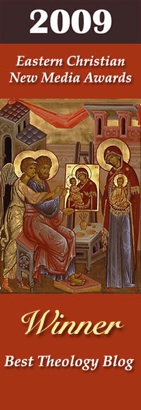Somebody asked Abba Antony (St. Antony the Great of Egypt), “What shall I do in order to please God?”
He replied, “Do what I tell you, which is this: wherever you go, keep God in mind; whatever you do, follow the example of Holy Scripture; wherever you are, stay there and do not move away in a hurry. If you keep to these guide-lines, you will be saved.”
+++
 This small story from the lives of the Desert Fathers has always reminded me of the quote that Fr. Thomas Hopko offers as having been given him by his mother when he left for seminary: “Remember God. Say your prayers. Go to Church.”
This small story from the lives of the Desert Fathers has always reminded me of the quote that Fr. Thomas Hopko offers as having been given him by his mother when he left for seminary: “Remember God. Say your prayers. Go to Church.”
The Christian life, it would seem, is not so much complex as difficult and the things that are difficult are themselves quite simple. St. Antony’s admonition to “follow the example of Holy Scripture” might seem to some to be asking the impossible – but he means nothing more than keeping its commandments. And those commandments are simple as well: love God, love neighbor, forgive everyone for everything (that’s my summary), do not lie, do not steal, and such things.
The difficulties that we encounter are a “living diagnosis” that something is wrong. When I lie, it is clear that something is wrong. The inside of me and the outside of me do not match – I have no integrity. Our lies are a refusal to live in the truth.
The failure to love is equally a diagnosis and evidence of the disordered condition of our lives. Christ’s teaching in Luke chapter six makes the point that the love and forgiveness that are asked of us are commandments to be like God:
But if you love those who love you, what credit is that to you? For even sinners love those who love them. And if you do good to those who do good to you, what credit is that to you? For even sinners do the same. And if you lend to those from whom you hope to receive back, what credit is that to you? For even sinners lend to sinners to receive as much back. But love your enemies, do good, and lend, hoping for nothing in return; and your reward will be great, and you will be sons of the Most High. For He is kind to the unthankful and evil. Therefore be merciful, just as your Father also is merciful (32-36).
And though a commandment to be “like God” can sound like the request for the impossible – we are never commandment to be like any other. We are created in God’s image and conformity to that image is our proper, natural condition. To live in the image of God is properly what it means to be truly and fully human.
And so our difficulty with all of this is evidence that something is wrong – something is disordered.
Without great analysis of the disease itself, St. Antony (and Fr. Tom’s mother), offer a straightforward remedy: wherever you go, keep God in mind; whatever you do, follow the example of Holy Scripture; wherever you are, stay there and do not move away in a hurry. Remember God. Say your prayers. Go to Church.
The first admonition, “to remember God,” is to learn to live as a creature – to live as a contingent being (to get philosophical). I did not create myself and were I to live as though I did, it would be a lie. Such a lie is a disordered way of being. Remembering God is not unrelated to the maxim of Socrates: “Know yourself.” The forgetting of God is one of the illnesses of the heart that dominates our secular world. For it is not so much that our world says that “there is no God,” as it says, “God is not here.”
The practice of saying the ‘Jesus Prayer’ is one of the most common ways that the “constant remembrance of the name of God” is manifest in the Orthodox spiritual life. But at the heart of that prayer is simply the remembrance of God. In the words of an old friend who was a recovering alcoholic: “The only thing you need to know about God is that you’re not Him.” And we need to know that every minute of the day.
The last thoughts of St. Antony’s admonition and the last thought offered by Fr. Hopko’s mother are quite similar as well. To stay where you are and not move about in a hurry is the practice of the virtue of stability. The gather regular for prayer in Church with other believers is the foundation of spiritual stability in our daily lives. To gather regularly and faithfully requires that our life in Church be purged of many of our modern (and ancient) habits. We must learn not to judge (or before long attendance becomes either unbearable or practice for dwelling in hell). We must learn that we exist to give praise and thanks to God and not be entertained. Boredom is not the bane of our existence – it is our hatred of existence.
We have now passed the climax of a great feast. Life returns to normal. At least we should pray for life to return to normal, understanding that to remember God, to keep the commandments, and to be content with our lives as creations of the living God is the true meaning of normal.











